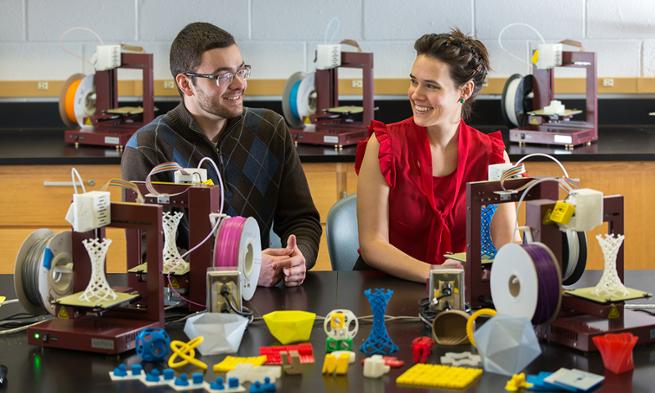Cross-disciplinary locomotion study
Science and Technology
Jeff Kopsick took his undergrad research to a new level with 3D printing technology
In a petri dish, they're barely visible to the naked eye, appearing more like sand grains than living creatures. Under a microscope, the 1 mm long roundworms look and move around just like typical worms.
For Jeff Kopsick, a biology major and a mathematics minor, the tiny organisms provided an opportunity to combine interests in both disciplines for a mathematics research project this summer. Kopsick wondered what could be learned about the movements of the worms by putting them in a maze filled with liquids of varying viscosities. And would it even be possible to build a maze small enough to test any mathematical theories?
Kopsick, a junior, learned that he could build a microscopic maze with a 3D printer in the math department's newly established Maker Lab, thus enabling him to further study the worm movements. He came up with the idea during classes and presentations last year, but he wasn't sure how to go about starting a research project. One thing he was certain about was that faculty would listen to his idea. "The nature of the university is just, you have that door open. There's no, 'Hey, I don't want you. ' It's, 'Let's hear what you have to say. Oh, maybe this could work,'" said Kopsick, who plans to write a journal article about his project.
His advisor, Dr. Eva Strawbridge, said she helped make the project feasible, but Kopsick made it work. "He's very independent. It was his design. He was the one who was doing the talking to the dean when the dean came to visit and he was the one who completely handled a visit from the president."
Added Kopsick, "Working in this lab has just been a great opportunity and I'm very thankful for being able to learn so many different skills, whether it be an intro to programming or an intro to fluid mechanics."
In addition to the 3D printer, Kopsick used a custom microscope built at JMU and a rheometer, a device used to measure a liquid's viscosity. Both devices are housed in the math department's Wiggling Organism Research and Modeling (WORM) Lab.
Strawbridge, an assistant professor of mathematics and statistics, said Kopsick's research has mathematical significance. "When you put objects in a fluid, it's not just an object interacting with another object, it's the object interacting with this fluid which then interacts with the object. You have a lot of interactions going on and the way Jeff has designed the environment, we can start to model the fluid interaction."
Kopsick's roundworm locomotion study was just one of 14 projects student math researchers tackled this summer at JMU. Other projects involved predicting the success of National Basketball Association teams in playoff series, exploring how a multi-legged robot could change speeds and creating a matrix population model for Monarch butterflies. The student researchers received stipends for their work, some funded by the National Science Foundation and others funded internally.
